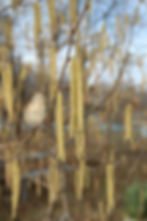Lead Plant (Amorpha canescens) is a resilient and striking perennial native to the prairies and grasslands of North America. This species is highly valued for its adaptability to a wide range of soil types, making it an excellent choice for xeriscaping, native plant gardens, and prairie restorations. Characterized by its silvery-green foliage and striking spikes of purple flowers, Lead Plant adds both beauty and ecological value to any landscape.
This plant typically reaches heights of 2 to 3 feet and blooms in mid to late summer, producing clusters of vibrant purple to bluish-purple flowers that stand out against its dense, silvery leaves. Its upright, shrub-like form creates visual interest, making it a great addition to naturalistic gardens or native plantings.
Lead Plant is particularly important for pollinators, providing vital resources for a wide variety of insects. The plant is a favorite of native bees, including bumblebees and sweat bees, which are attracted to its rich nectar. Butterflies also frequent Lead Plant for its nectar. Additionally, various species of moths are drawn to the plant’s flowers during the evening hours. The Lead Plant’s nectar-rich blooms provide a crucial food source for pollinators in late summer when other plants may have finished flowering.
In addition to its role in supporting pollinator populations, Lead Plant contributes to soil stabilization and erosion control due to its deep, fibrous root system. This makes it an invaluable plant for prairie restorations, erosion-prone areas, and as a hardy, low-maintenance landscape addition.
By incorporating Lead Plant into your garden or restoration project, you can support local pollinator populations while enhancing your landscape with a beautiful, drought-tolerant, and ecologically significant plant. Whether you're focused on sustainability, wildlife conservation, or simply enjoying the beauty of native flora, Amorpha canescens is a superb choice.
Lead Plant
- Perennial
- Prefers full to partial sun
- Preferes medium to dry soils
- Reaches heights of 3'-4'
- Blooms from June to August



















